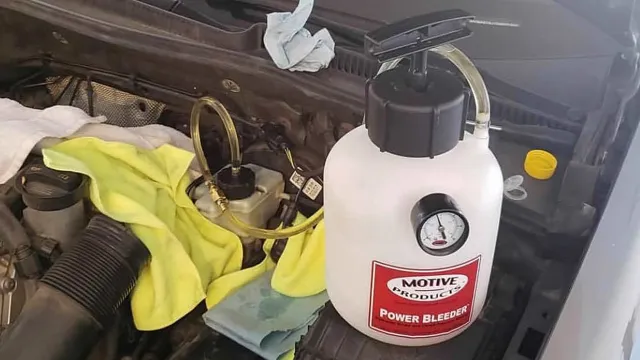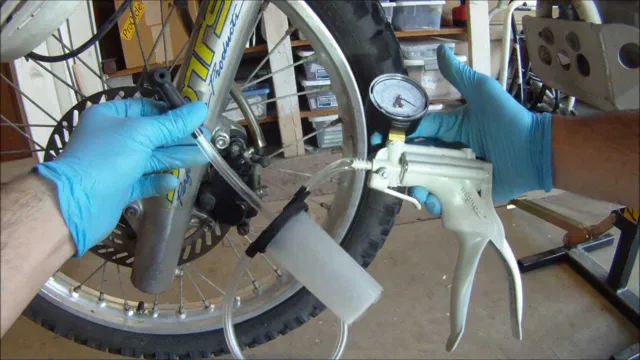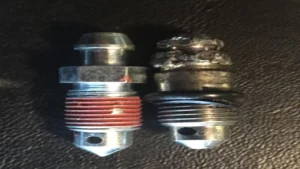If you’re facing brake issues, and you’d like to try your hand at fixing them yourself, then investing in a Mityvac brake bleeder is an excellent choice. This tool is designed to help you remove air bubbles from your brake fluid, which can significantly enhance your brake system’s performance and durability. The Mityvac brake bleeder is especially useful if you have a hydraulic brake system, but it can still work for mechanical systems as well.
Not only is using a Mityvac brake bleeder more accurate than the traditional “pump and hold” method, but it’s also much more efficient. The process is quick and easy, and it doesn’t require any additional help. Moreover, the tool is relatively easy to use, even for beginners.
Whether you’re a professional mechanic or a DIY enthusiast, the Mityvac brake bleeder is a worthwhile investment that you won’t regret. In this blog, we’ll walk you through how to use the Mityvac brake bleeder step by step. We’ll explain how the tool works, what you need to get started, and how to use it correctly to ensure the best results.
By the end of this post, you’ll have all the information you need to bleed your brakes like a pro and ensure that your vehicle is running smoothly and safely. So, let’s get started!
What is a Mityvac Brake Bleeder?
If you’re a car owner, there’s nothing more frustrating than dealing with a brake system that isn’t working properly. A mityvac brake bleeder is a tool that can help you with this issue. This tool is specifically designed to remove any air bubbles that may be trapped in your brake lines, ensuring that brakes work efficiently.
When using a mityvac brake bleeder, it’s essential to follow the manufacturer’s instructions closely. You will need to attach the tool to your vehicle’s brake system and pump out the old brake fluid while simultaneously drawing new fluid into the system. The process may take some time, but with patience and care, you can ensure that your brakes are in good working order.
The mityvac brake bleeder is a must-have tool for any DIY mechanic who wants to keep their car’s brake system running smoothly.
Description of brake bleeder tool
If you’re a DIY person who loves to fix things yourself, then you must understand the importance of brake maintenance. And when it comes to brake bleeding, nothing can beat the efficiency and ease of a Mityvac brake bleeder. A Mityvac brake bleeder is a handheld vacuum pump that helps in removing air bubbles from your car’s brake lines and replaces old brake fluid with new fluid, ensuring your brakes work perfectly fine.
It comes with a wide variety of accessories to fit different brake systems and has a simple operation process that needs minimal effort. Using a Mityvac brake bleeder saves you time and money that you would otherwise spend on a professional mechanic. Just attach it to your brake system, and it will do the job perfectly in no time.
So, if you want to keep your car’s brake system in good shape, investing in a Mityvac brake bleeder is a smart choice.

Prepping for Brake Bleeding
If you’re looking to bleed your brakes at home and want a professional finish, using a Mityvac brake bleeder is a great option to consider. First and foremost, you’ll want to gather all the necessary tools before beginning the process. These may include various wrenches, tubing, and a Mityvac brake bleeder kit.
Once you have everything you need, it’s time to locate the brake bleeder screws and connect the tubing to the bleeder valve. From there, you can proceed with the bleeding process by using the Mityvac brake bleeder to create a vacuum and remove any air bubbles from the brake lines. As you work, be sure to keep an eye on the brake fluid level in the master cylinder and ensure that it stays topped up to avoid introducing more air into the system.
By following these steps carefully, you can achieve a professional-grade brake bleed without spending a ton of money at the mechanic.
Procedure for checking brake fluid level
When it comes to checking your brake fluid level, there are a few important steps you need to take to ensure your brakes are functioning properly. The first thing you’ll need to do is prep for brake bleeding. This involves making sure your car is parked on a flat surface and that the engine is turned off.
You’ll also need to locate your vehicle’s brake fluid reservoir, which is typically located near the brake pedal. Once you find it, remove the cap and use a clean cloth to wipe away any dirt or debris. Then, use a dipstick or your finger to check the level of the fluid.
If it’s low, you’ll need to add more brake fluid until it reaches the recommended level. Remember to use the correct type of brake fluid for your vehicle, as using the wrong type could cause damage to your braking system. By properly prepping for brake bleeding and checking your brake fluid level on a regular basis, you can help ensure your vehicle’s brakes are functioning at their best.
Priming the brake bleeder tool
Priming the brake bleeder tool is a crucial step in prepping for brake bleeding. You wouldn’t want any air bubbles in the system, would you? Priming is easy. All you need to do is fill the bleeder tool’s reservoir with brake fluid and ensure there is no air in it.
Just pump the handle until you see the fluid reach the top. It’s just like priming a water pump. Don’t forget to keep checking the reservoir and refill it as needed during the brake bleeding process.
It’s essential to have a well-primed brake bleeder tool for successful brake bleeding. So take your time and make sure everything is ready to go before starting the job.
Bleeding the Brakes
If you need to bleed your brakes, the Mityvac brake bleeder is an excellent tool to make the job easier. Bleeding the brakes means removing any air bubbles that have formed in the brake system and ensuring that the brake fluid is working properly. The Mityvac brake bleeder is a vacuum pump that pulls the old brake fluid out of the system and replaces it with new fluid.
First, connect the bleeder to the brake fluid reservoir and the pump hose to the bleeder itself. Then, open the bleeder valve and vacuum out the old fluid. Be sure to keep an eye on the brake fluid level in the reservoir during the process, as you don’t want it to run dry.
Once all the old fluid has been removed, close the bleeder valve and refill the reservoir with fresh brake fluid. Finally, pump the brakes several times to work out any remaining air bubbles. The Mityvac brake bleeder makes the process quick and easy, and you’ll have peace of mind knowing that your brakes are working at their best.
Identifying the correct bleeder valve
When bleeding your brakes, it’s crucial to identify the correct bleeder valve on each wheel. This valve is typically located on the brake caliper or drum and allows air to escape from the brake system, ensuring proper brake performance. To locate the valve, consult your vehicle’s owner’s manual or online resources specific to your make and model.
A common technique is to have a helper press the brake pedal while you locate the valve and attach a bleeder hose to it. Then, slowly loosen the valve to allow air and old fluid to escape until only clean fluid flows through the hose. Repeat on all wheels until the brake system is bled completely.
Remember, correct identification of the bleeder valve is crucial to ensure your brakes function correctly and keep you safe on the road.
Attaching the brake bleeder tool
Attaching the brake bleeder tool is a crucial step in properly bleeding your car’s brakes. Before getting started, you’ll need to gather all of the necessary tools and materials. Once you have everything you need, locate the brake bleeder valve on the caliper or wheel cylinder and remove the cap.
Attach one end of the brake bleeder tool to the valve and the other end to a container that can hold brake fluid, ensuring it is secure and sealed. This container will catch the brake fluid as it’s released from the system. Next, open the valve slightly and have a helper press down on the brake pedal until no more air bubbles are visible in the tube.
Repeat this process for each brake until you have successfully removed all the air from the system. It’s important to note that if the bleeder valve is damaged or rusted, it should be replaced before bleeding the brakes. By properly attaching the brake bleeder tool, you can ensure that you are bleeding the brakes correctly and safely, which will give you greater confidence when driving your car.
Remember, safety is key when working on any part of your car, so take your time and always wear protective gear.
Pumping the brake pedal and opening/closing bleeder valve
“Bleeding the Brakes” If your brakes feel spongy or unresponsive, it could be due to air bubbles in the brake lines. This is when bleeding the brakes comes in handy. Bleeding the brakes involves removing the air from the brake lines to ensure maximum stopping power.
One common method of bleeding the brakes involves pumping the brake pedal and opening/closing the bleeder valve. Start by locating the bleeder valve on each brake caliper or drum brake. Then, attach a clear tube to the valve and place the other end of the tube into a container that’s partially filled with brake fluid.
Next, have someone pump the brake pedal a few times and then hold the pedal down. While the pedal is down, you can open the bleeder valve to release the air and brake fluid. Close the valve and repeat until there are no more air bubbles in the brake fluid.
It’s essential to check the brake fluid level during the process and refill it when necessary. Bleeding the brakes may take some time, but it’s a crucial step in keeping your brakes in tip-top shape and ensuring your safety on the road.
Confirming successful brake bleeding
Bleeding the brakes is a crucial part of maintaining your vehicle’s safety. It’s important to confirm that the brake system has been properly bled to ensure that there are no air bubbles present in the lines, which can affect the brake performance. One way to check if you’ve successfully bled the brakes is to do a brake pedal test.
Start by turning on the engine and pumping the brake pedal a few times to build pressure. Once pressure has been built, press down on the pedal and hold it for 30 seconds. If the pedal stays firm and doesn’t sink to the floor, then you’ve successfully bled the brakes and there are no air bubbles present.
However, if the pedal sinks, then air bubbles are still present and you’ll need to bleed the brakes again. Remember, proper brake maintenance is essential for your safety on the road, so don’t skip this important step.
Cleanup and Maintenance
If you’re wondering how to use a Mityvac brake bleeder, look no further! Before attempting to use your Mityvac brake bleeder, it’s important to perform some basic cleanup and maintenance. Start by inspecting all parts to ensure they’re free of dirt, debris, or damage. Then, lubricate all moving parts with a light coat of oil.
Next, flush the system with fresh brake fluid to ensure it’s free of any contaminants. Once you’re ready to use the Mityvac brake bleeder, simply attach it to the bleeder valve and pump the vacuum handle until all air bubbles have been removed from the brake line. Keep in mind that proper cleanup and maintenance can help ensure the longevity and effectiveness of your Mityvac brake bleeder.
Proper disposal of brake fluid
Brake fluid is an important component in our vehicle’s braking system as it plays a crucial role in ensuring efficient and safe braking. However, when it comes to the proper disposal of brake fluid, it is important to handle it with care. Improper disposal of brake fluid can lead to serious environmental damage as it contains harmful chemicals that can contaminate the soil and water.
Therefore, it is crucial to properly dispose of brake fluid to prevent harm to the environment. The best way to dispose of brake fluid is by recycling it. There are many service stations that offer recycling services for used brake fluid.
If you are not able to locate a service station in your area, you can contact local authorities for advice on how to dispose of it properly. Remember, by disposing of brake fluid properly, you are not only protecting the environment but also ensuring your safety while driving. So, let’s take a step towards sustainable and responsible living by properly disposing of our brake fluid.
Cleaning and storing the brake bleeder tool
Once you’ve finished using your brake bleeder tool, it’s important to clean and store it properly to ensure it lasts for years to come. Start by wiping down the tool with a clean, dry cloth to remove any excess brake fluid or debris. Next, use a brush or compressed air to get rid of any built-up dirt or grime in hard-to-reach areas.
Be sure to pay extra attention to the bleeder valve and hose connections. If your tool came with a protective case, store it in there to prevent dust and contamination. If not, wrap it in a clean cloth or paper towel and keep it in a dry, cool place.
Remember that neglecting to clean and store your tool could compromise its performance and accuracy, so make it a priority to maintain it regularly. In the end, a clean and well-maintained brake bleeder tool may end up saving you time and money, so don’t skimp on the TLC!
Conclusion
Using the Mityvac brake bleeder is as easy as pie, even for those who are new to car maintenance. It’s a tool that effortlessly removes air bubbles in your brake lines, giving you a smoother and more responsive braking system. So, don’t be shy, get the Mityvac brake bleeder and give your car the brake maintenance it deserves.
Your car will thank you, and you’ll feel like a true mechanic!”
FAQs
What is a Mityvac brake bleeder?
A Mityvac brake bleeder is a tool used to bleed the hydraulic system of a vehicle’s brakes.
How does a Mityvac brake bleeder work?
A Mityvac brake bleeder creates a vacuum that pulls air and old brake fluid out of the brake system, allowing fresh brake fluid to replace it.
Can I use a Mityvac brake bleeder with ABS brakes?
Yes, a Mityvac brake bleeder can be used with ABS brakes, but it may require additional steps.
How often should I use a Mityvac brake bleeder?
It is recommended to use a Mityvac brake bleeder every time the brake fluid is changed or if air is detected in the brake system.
Is it easy to use a Mityvac brake bleeder?
Yes, using a Mityvac brake bleeder is relatively easy and straightforward, and many people do it themselves to save time and money.
Can I use a Mityvac brake bleeder on other hydraulic systems besides brakes?
Yes, a Mityvac brake bleeder can be used on other hydraulic systems such as clutches, power steering, and shocks.
How do I maintain my Mityvac brake bleeder?
It is important to clean and dry the Mityvac brake bleeder after each use and keep it in a dry place to prevent rust and corrosion. It may also need occasional calibration and replacement of parts.






